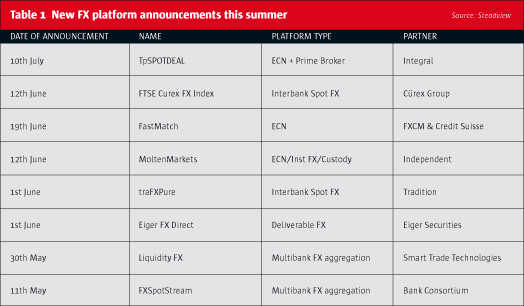Since June, there has been a flurry of developments involving foreign exchange market providers. Five new ECNs (Electronic Communications Networks) have been announced during July alone, with the most notable launches coming from inter-dealer broker(s) – Tradition with platform ‘traFxPure’ and Tullet Prebon with ‘tpSpotdeal’. There has also been a similarly themed launch from the Curex Group and the FTSE with ‘FTSE Curex FX Index’.
Each of these platforms correspond to the same theme of seeking to create more of an equal playing field in institutional FX markets, with the FTSE Curex FX index particularly focused on using a quoted Index to develop this. The main reason given for this, particularly over the last few months, has been the depth of access that some entities are able to leverage to the main exchange networks, versus lower depth for the smaller entities. Each of these products, in varying forms and adaptations, aims to control and manage this.

Recent launches have not been limited to the top-tier technology-side of the FX. US company SmartTrade Tech has launched a new platform ‘Liquidity FX’, designed to provide a more comprehensive offering of liquidity and trading access, principally to lower-tier banks and entities. The new ‘rules’ however, are virtually identical in nature with those being introduced at the top-tier level. Retail FX also has been the focus of the same correlated trends. FXPro, one of the largest retail FX trading companies in the world with over 15,000 clients from 150 countries and with trading volumes of around $95 billion per month, announced in July that it was switching from market-making to an agency model for all of its trading operations.
With regards to the bank space also, June and July were busy months in terms of general developments and announcements. One of the more notable events was the re-launch of Deutsche Bank’s Autobahn FX platform, which, according to Deutsche Bank, now provides greatly enhanced control and access to liquidity for the end user.
At the deliverable foreign exchange level also, the beginning of the month saw Mexican-based ‘Monex Group’ purchase Schneider Foreign Exchange Ltd in London, in a cash deal at a reported valuation of around $100 million. The acquisition makes Monex Group one of the largest deliverable foreign exchange operations in the world, turning over $125 billion (in forex transactions) annually.
These recent developments in foreign exchange markets all have something in common. Aside from a clear desire on the part of: more entities to adapt to take advantage of lower margin higher liquidity, there is a discernible shift in attitude towards more ‘ethical’ markets. The two FX platform launches from inter-dealer brokers Tullet Prebon and Tradition are both specifically designed to make market-access ‘fairer’ and more transparent to all parties involved in transactions. ICAP has also announced changes this month to its EBS platform (the largest FX Inter-Dealer platform in the world) over the type of rules and access it grants to its participants. These changes will reportedly make the platform significantly less hindered by sharp trading practices where ‘predators’ attempt to ‘game’ other participants.
Transparency and ‘fairness’ then are the two main themes being utilised, across the spectrum, from FXPro’s move to ‘agency’, to cope with an increased demand for lower spreads from retail markets, all the way up to ICAP’s Institutional EBS platform, to try and create a more level playing field. These developments are all focused on both the higher and lower ends of the trading spectrum. Institutional FX participants are demanding fairer access to one another and to exchanges and networks with fairer rules, whilst retail FX traders are demanding increasingly tighter margins.
However, the missing link between the lower and higher market levels is the mid-section. Funds, fund administrators and corporates are currently missing out on this recent drive for value and transparency. Those entities in this mid-range that want to trade foreign exchange face the dilemma of being unable to meet both the volume, and counterparty-credit requirements of the larger exchangesand top-tier institutional entities. At the same time, such entities are simply not willing or not able to undertake the counterparty risk and poor settlement arrangements that come with dealing with smaller retail FX operations.
On the FX for delivery front, where many funds, administrators and companies still pay vastly inordinate costs on their currency trades and settlements, the quandary is almost identical. On the one hand, the lending and custodian banks who carry the easiest settlement function and the stronger counterparty position, charge often obscure and convoluted prices, whilst the swarm of retail foreign exchange brokers who advertise sharper pricing, carry very high counterparty and settlement risk.
The recent drive for fairness and transparency in FX markets still has some way to go. There is a clear need for a bridge between expensive transactions and low risk outlook, and cheaper transactions and higher risk outlook. Having identified this need, Eiger FX, as part of the inter-dealer capital markets offering from the Eiger Group, is launching its new FX platform at the end of the summer. This platform is aimed particularly at the mid-space of the FX market.
As an inter-dealer broker, the Eiger Group aims to accommodate entities on the counterparty risk front, whilst also maintaining a personal emphasis on creating fixed and transparent FX margins for all entities transacting via its platform.
Samuel Garnett has worked in FX dealing and trading for the the last six years. He joined the Eiger Group in 2011 to set-up the foreign exchange desk.
- Explore Categories
- Commentary
- Event
- Manager Writes
- Opinion
- Profile
- Research
- Sponsored Statement
- Technical
Commentary
Issue 79
Foreign Exchange Market Providers
A flurry of developments
SAMUEL GARNETT, EIGER FX
Originally published in the August 2012 issue